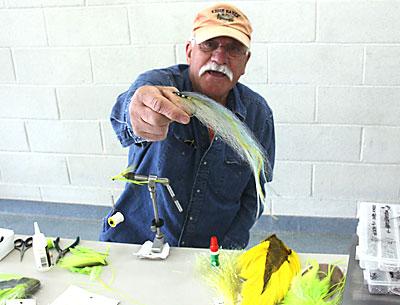On the Water 04.26.12

Alfonso Marino stopped casting into the Georgica Pond gut as the water flowed into the sea. He stopped casting flies and watched in awe as Mother Nature did her spring thing shortly after the pond was opened to the sea on April 2 by order of the East Hampton Town Trustees.
Trustees open it each spring and fall — when storm-driven ocean waves do not — in order to accommodate the fish that leave as fry and return to spawn as they have for millenniums.
“I had never seen the alewives come up until this year. I stopped fishing to watch them. How interesting it was to see how some were smarter than others, swimming around on the sides while others fought the current. The gulls peck at them to wound them.”
“They’re a beautiful iridescent fish. Fascinating to see how they reacted. The birds were on them. That’s how I knew they were there. They were coming in pods, singles, or four or five together.” After his fit of amazement, Marino caught and released several stripers. He fishes with barbless hooks.
He’s a fly fisherman, for the most part, and ties flies during the winter months in preparation for “every day,” when the striped bass begin their run.
“I fly-fish exclusively. I do have a spinning rod for emergencies, like when the wind blows 40 miles per hour,” he said. His usual schedule takes him to the Georgica gut and other oceanside spots for the early run, and Montauk every day during the fall. “If my friends are there with spinning rods, they let me in,” he said alluding to a blocking strategy that protects him from the often-aggressive territoriality of spin-casting surf fishermen.
He has 9 and 10-weight rods, bigger flies, and heavier line to deal with conditions on the ocean side, but prefers a 6-weight to catch bass up to 34 inches in the bay. “That’s a really good fish,” he said, a good size for a light rod. “If you give the fish pressure immediately, it has a shot,” a sporting chance, he said. “I don’t care about the next fish, I’m enjoying this fish. I can enjoy the little ones, and I can beat the bigger guys.”
While a magnificent fish, striped bass are not the best fighting fish, he said. “I’d rather catch a bluefish any time.”
Except for the month of October — “just looking at my logs,” Oct. 10 was the best — last year’s surfcasting fell short of expectations. Marino blames sand eels for staying too far offshore. “If bait is not on the beach, when the peanuts [peanut bunker] aren’t on the sand, especially in the fall, the fly-fishing is no good. The peanuts bring the blues, the bass come in right behind them.”
The bigger flies Marino displayed at the sportsmen’s expo held at the Amagansett Firehouse on Saturday were designed for stripers of the rotator-cuff-tearing size, the ones feeding on herring and bunker flies. “I use different colors, just leave them in the water, you don’t have to ‘strip’ them [lure fish with line-retrieval finesse].”
Nor does he strip the deceiver flies that he ties with feathers on top of them rather than on the sides in the style of fly-fishing guru Ken Abrames. “When the feather gets in the current, it undulates. You don’t have to work it. You need current.”
Most of Marino’s catches are returned, but every once in a while he keeps a bass to cook “Italian style” with a Livornese sauce — “capers, tomatoes, onions. I’ll simmer the sauce first with the bass in another pan just to give it a hit. Then, I let it sit in the sauce for 10 minutes. You don’t want to overcook the fish.”
Fishermen often link themselves to the food chain, so it’s worth mentioning that squid and blowfish have entered Gardiner’s Bay in healthy numbers, a development pleasing to both striped bass and human lovers of calamari and blowfish-tail scampi.
It was while dressing a table-bound fish that Marino was drawn to the stomach contents, which included several species of crab. “My head told me the bass were on the bottom. You need things with eyes [lead] to get down there,” a type of fly known as a Clouser. Using photos of the crabs in mid-digestion, Marino designed crab-pattern flies that have proved very productive. “My workhorse flies.”
Speaking of fly-fishing and alewives, Harvey Bennett of the Tackle Shop in Amagansett recalled his younger days tramping along the banks of Little Reed dreen in Montauk tracking alewives as they worked their way up into Big Reed Pond from Lake Montauk. “Me and Charlie Whitmore would cast Mickey Finns at them, red and yellow freshwater flies. It pissed them off. They’d hit it and jump about three feet in the air. We’d laugh our asses off.”
Bennett explained that, like spawning salmon, alewives would not bite on the flies because they were hungry — they are filter feeders — but because they aggravated them.
In other fishy news, Steve LaPani, a freshwater aficionado, caught and released seven largemouth and one smallmouth bass in Montauk’s Fort Pond on Saturday, a perfect day to play Huck Finn.
And, a reminder: The recreational fluke season will get under way on Tuesday with a 19.5-inch minimum size and a four-fish-per-day bag limit.
The Montauk SurfMasters spring fling competition is scheduled to begin on May 11 and run through June 30.
